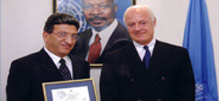By Najib Saab, Issue 31, October 2000
The crisis of scientific journalism in the Arab region has long been the subject of discussion in both media and science circles. A meaningful approach to the dilemma begins by breaking it down into its basic components: The state of Arab journalism in general, and the deficiencies of scientific research across the Arab countries.
Arab media lack well-trained investigative journalists, who are backed by their organizations to track news to the deepest sources and analyze events, based on facts and figures. That is why Arab news usually takes on a "descriptive coverage" trait. In this context, writing about a press conference to announce the launching of a development project, would be limited to information contained in ready-made press releases, often meant for public relations, without any attempt to scrutinize the program or question its feasibility, let alone carrying any follow-up during execution, in order to pinpoint successes and failures. We rarely see reports in the Arab press comparing the end results of a certain project to the goals promised when the project was launched.
We also notice that more often than not, the best pictures of local news are those taken by the international news agency photographers, whereas the local photojournalists are content with shots of celebrity meetings and general scenery, that are not up to par with the event at hand. A Dutch nature photographer has commented that most shots of animals and birds he has seen in Arabic books are either of dead creatures, or copied from foreign sources. It is also rare for any Arab media to commission a reporter to carry out a comprehensive investigative account on any given subject, be it on scientific, economic, social or even crime matters, which could take months to prepare, with the final product limited to 1000 words article in a newspaper or a ten-minute documentary on television. This might sound expensive reporting and programming. Yet, it is this kind of journalism that makes the difference and shapes public opinion.
Arab writers and photojournalists do not lack the talent to produce high quality journalism. However, such level and type of reporting requires support and endorsement from the institution, including backing with resources and protection against political and economic powers who might be affected by candid reporting. We know of many Arab journalists who have lost their jobs as a result of one line of criticism in a single article.
This being the problem of Arab journalism, science in our countries fares no better, as it is often based on imitation rather than innovation. The lack of serious scientific research is due to the feeble budgets assigned to it, as if it were a dispensable luxury for poor Arab countries, or a commodity that could be bought from the international supermarket by rich Arabs. As in journalism, Arab scientists do not lack the creativity needed to excel, but they do lack sufficient backing of strong scientific institutions.
Therefore, we are facing a journalistic crisis, a scientific crisis and a scientific journalism crisis, all at the same time. Environment is but a branch of all.
Scientific journalism includes specialized topics that target the readers in general. It is divided into two categories; the first addresses specialized readers from various backgrounds, while the second addresses the common readers, basically anyone who can read. The first type reports on heart diseases and construction materials, for example, in a language that can be understood by the engineer, the lawyer, the mathematician and any specialist in the advanced fields of education. The second type of scientific journalism presents the scientific subject with accuracy and simplicity for all readers, whether they were specialized in a specific subject or not. That is popular science.
Mass circulation publications with scientific titles belong to the category of popular science. They are specialized titles addressing the general public. In this respect, they present scientific topics in the perspective of their influence over people's lives. They do not, for example, deal with the subject of biodiversity as an intellectual luxury and pure science, but rather emphasize its effect on life itself. Destroying a forest, for instance, might destroy a yet undiscovered kind of plant that could in the future carry a cure for cancer. Climate change could cause a high rise in sea levels and the destruction of coastal areas, and thus eradicate complete communities and cultures. Popular scientific journalism acquaints science with daily life, and goes beyond mere reporting of events to structured analysis.
|




